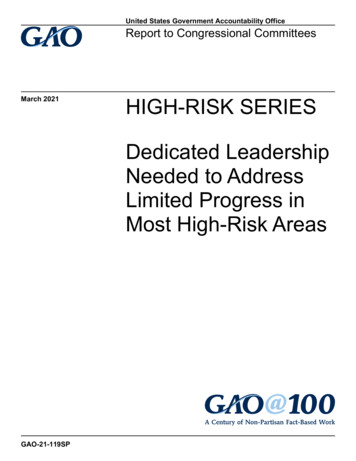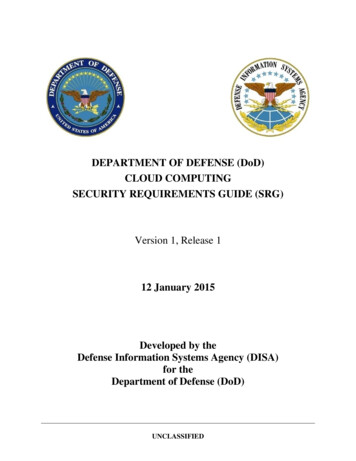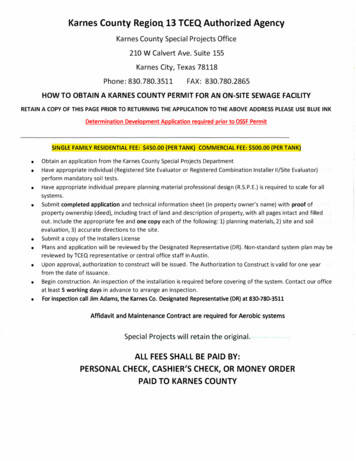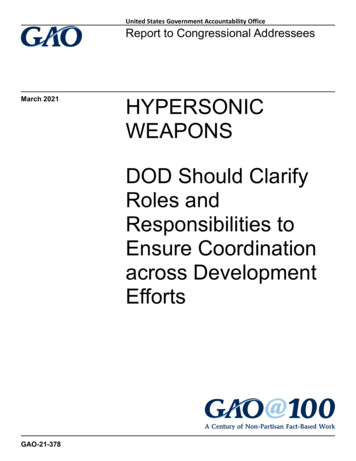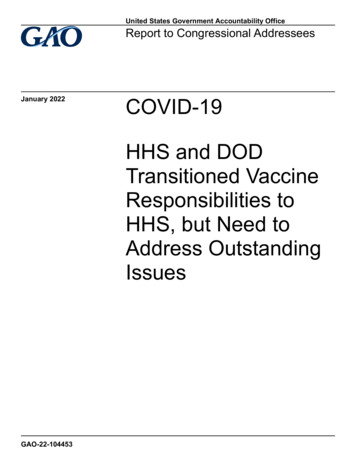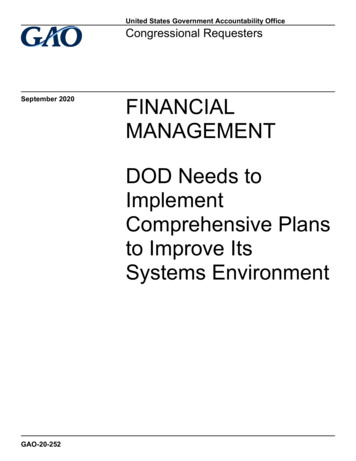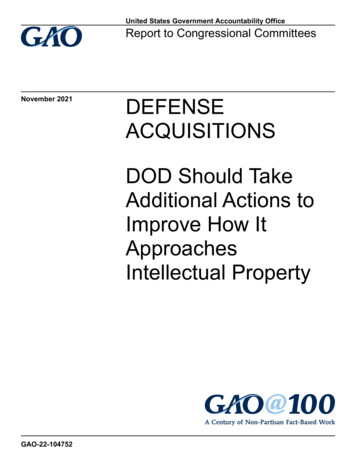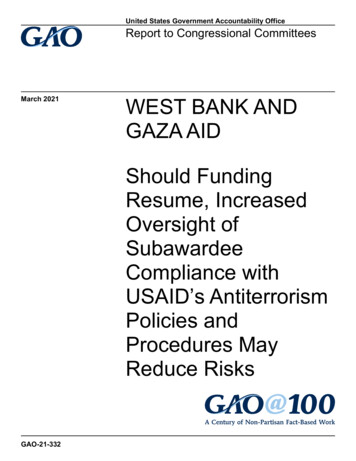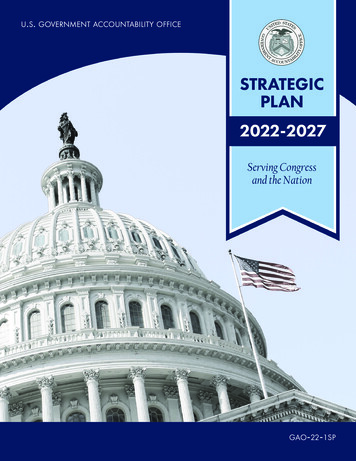
Transcription
United States Government Accountability OfficeGAOReport to Congressional RequestersSeptember 2011DOD FINANCIALMANAGEMENTMarine CorpsStatement ofBudgetary ResourcesAudit Results andLessons LearnedOn October 17, 2011, this report was revised to correct a portion ofTable 4, in Appendix II that was inadvertently omitted duringpublishing. Specifically, omitted text that was restored is at the end ofthe table: NFR-53, NFR-54, and NFR-55.GAO-11-830
September 2011DOD FINANCIAL MANAGEMENTMarine Corps Statement of Budgetary ResourcesAudit Results and Lessons LearnedHighlights of GAO-11-830, a report tocongressional requestersWhy GAO Did This StudyWhat GAO FoundLong-standing weaknesses inDepartment of Defense (DOD)business processes, systems, andcontrols have hindered efforts toachieve financial audit readiness.Because DOD relies heavily on budgetinformation for day-to-daymanagement decisions, in August2009, the DOD Comptroller designatedthe Statement of Budgetary Resources(SBR) as an audit priority. The U.S.Marine Corps was identified as thepilot military service for an SBR audit.GAO was asked to determine (1) theprimary reasons the Marine Corps wasunable to obtain an opinion on its fiscalyear 2010 SBR; (2) the effectivenessand status of the Marine Corps’remediation plan, and (3) militaryservice efforts to leverage MarineCorps SBR audit lessons. GAOreviewed auditor findings andrecommendations, evaluated theMarine Corps corrective action plans,and reviewed documentation onmilitary service audit readiness andlessons learned efforts. During itswork, GAO met with DOD, MarineCorps, military service, and DefenseFinance and Accounting Service(DFAS) officials and the auditors.The Marine Corps received a disclaimer of opinion on its Fiscal Year 2010 SBRbecause it ould not provide supporting documentation in a timely manner, andsupport for transactions was missing or incomplete. Auditors also reported thatthe Marine Corps did not have adequate processes, systems controls, andcontrols for accounting and reporting on the use of budgetary resources. Further,the Marine Corps could not provide evidence that reconciliations for key accountsand processes were being performed on a monthly basis. The auditor alsoidentified ineffective controls in key information technology (IT) systems used bythe Marine Corps to process financial data. The auditors provided 139recommendations to correct identified weaknesses.What GAO RecommendsGAO makes recommendations to(1) the Marine Corps to develop a riskbased remediation plan and confirm itsactions fully respond to auditorrecommendations and (2) DOD todirect other military services toconsider key lessons learned in theiraudit readiness plans, as appropriate.DOD concurred with three of fourrecommendations but said therecommendation for a risk-based planwas too prescriptive. GAO believes thisis needed for the long term.View GAO-11-830 or key components.For more information, contact Asif A. Khan at(202) 512-9869 or khana@gao.gov.The Marine Corps developed action items and milestones in response to theauditor’s findings. But its remediation plan was focused on near-term outcomesand did not adequately specify key elements, including goals and objectives,actions for addressing those objectives, and associated performance measures.GAO previously reported that it is standard practice to have strategy that includesthese features. GAO found that many of the Marine Corps’ actions did notaddress the specific auditor recommendations, and other actions were notadequate to correct underlying problems or root causes. Further, many of theremediation actions would require steps on the part of other DOD components,such as DFAS and the Defense Contract Management Agency. As of July 2011,the Marine Corps reported that actions on 88 of the 139 auditorrecommendations were fully implemented. Auditors will assess the effectivenessof these actions as part of the fiscal year 2011 SBR audit effort. However,because many of the actions do not address the underlying internal controlweaknesses, the Marine Corps risks continuing disclaimers of opinion.The Marine Corps’ fiscal year 2010 SBR audit results provide valuable lessonson preparing for a first-time financial statement audit. GAO identified fivefundamental lessons that are critical to success. Specifically, the Marine Corps’experience demonstrated that prior to asserting financial statement auditreadiness, DOD components must confirm completeness of populations of transactions and address any abnormaltransactions and balances,test beginning balances,perform key reconciliations,provide timely and complete response to audit documentation requests, andverify that key IT systems are compliant and auditable.These issues are addressed in Internal Control Standards and auditrequirements as well as DOD’s Financial Improvement and Audit ReadinessGuidance, which the military services are to follow in developing their respectiveFinancial Improvement Plans (FIP). Navy, Army, and Air Force FIP officialsstated that they were aware of the Marine Corps lessons. Navy officials statedthat they are in the process of updating their audit readiness plan to address allfive areas. Army and Air Force officials indicated their plans addressed some butnot all of the lessons.United States Government Accountability Office
ContentsLetter1BackgroundInadequate Support for Accounting Transactions and IneffectiveControls Led to Disclaimer on the Marine Corps’ SBRMarine Corps Remediation Plan Is Focused on Near-TermOutcomesLessons Learned from the Marine Corps’ SBR Audit EffortConclusionsRecommendations for Executive ActionAgency Comments and Our Evaluation31018232424Appendix IObjectives, Scope, and Methodology29Appendix IIReported Status of Marine Corps Actions on Recommendations fromthe Fiscal Year 2010 Statement of Budgetary Resources Audit Effort31Appendix IIIComments from the Department of Defense65Appendix IVGAO Contact and Staff Acknowledgments697TablesTable 1: DOD IG Recommendations, Reported Status of USMCActions on Accounting and Financial Reporting ProcessIssues as of July 18, 2011, and DOD IG Confirmation ofStatus as of August 25, 2011Table 2: DOD IG Recommendations, Reported Status of USMCActions on MCTFS Information Technology System Issuesas of July 18, 2011, and DOD IG Confirmation of MarineCorps Statuses as of August 25, 2011Table 3: DOD IG Recommendations, Reported Status of USMCActions SABRS Information Technology System Issues asof July 18, 2011, and DOD IG Confirmation of MarineCorps Status as of August 25, 2011Page i314550GAO-11-830 Marine Corps FY 2010 SBR Audit Effort
Table 4: DOD IG Recommendations, Reported Status of USMCActions on DDRS Information Technology System Issuesas of July 18, 2011, and DOD IG Confirmation of Status asof August 25, 201156Figure 1: Marine Corps Trend Analysis on Estimated Obligationsand Liquidations Related to Fiscal Year 2010 Officer MADCPSDDRSDDRS-AFSDDRS–BPage iiAcquisition CategoryAccessor IdentificationAntideficiency ActSoftware AGBusiness Impact AnalysisBusiness Transformation AgencyComputer AssociatesCertification and AccreditationCommon Access CardConfiguration Control BoardChief Financial OfficerConfiguration ItemsCustomer Information Control SystemClevelandConfiguration Management BoardCommit, Obligate, and ExpendContinuity of OperationsContracting Officer Technical RepresentativeDesignated Accrediting AuthorityDatabase AdministratorDefense Contract Audit AgencyDefense Cash Accountability SystemDefense Contract Management AgencyDefense Civilian Pay SystemDefense Departmental Reporting SystemDefense Departmental Reporting System–AgencyFinancial ReportingDefense Departmental Reporting System–BudgetaryGAO-11-830 Marine Corps FY 2010 SBR Audit Effort
DDRS–DCM Defense Departmental Reporting System–Data CollectionModuleDEAMSDefense Enterprise Accounting and Management SystemDECCDefense Enterprise Computing CentersDICDocument Identifier CodeDLTDesign Logic ToolDFASDefense Finance and Accounting ServiceDFAS–CLDefense Finance and Accounting Service–ClevelandDFAS–CODefense Finance and Accounting Service–ColumbusDFAS–INDefense Finance and Accounting Service–IndianapolisDIACAPDOD Information Assurance Certification and AccreditationProcessDISADefense Information System AgencyDODDepartment of DefenseDONDepartment of the NavyDSSNDisbursing Station Symbol NumberELSIGElectronic SignatureeMASSEnterprise Mission Assurance Support SystemERPEnterprise Resource PlanningFASABFederal Accounting Standards Advisory BoardFBWTFund Balance with TreasuryFIARFinancial Improvement and Audit ReadinessFIPFinancial Improvement PlanFMFunctional ManagerFMRFinancial Management RegulationFOSFamily of SystemsFRDFunctional Requirements DocumentGAAPGenerally Accepted Accounting PrinciplesGDAGlobal Data AreaGFEBSGeneral Fund Enterprise Business SystemGLGeneral LedgerHQMCHeadquarters Marine CorpsIAInformation AssuranceIAOInformation Assurance OfficerICOFRInternal Control over Financial ReportingIGInspector GeneralITInformation TechnologyJADSJoint Application Development SessionsJVJournal VoucherLOALine of AccountingMCCATMarine Corps Administrative Analysis TeamMCOMarine Corps OrderPage iiiGAO-11-830 Marine Corps FY 2010 SBR Audit Effort
FROMBPanAPTPCSPINPMOPOAMPPAPTRPub. L. ITSLASMDSMD–CLSODSPOPage ivMarine Corps Permanent Duty TravelMarine Corps Program Review TeamMarine Corps Total Force SystemManpower InformationMilitary Standard Requisition and Issue ProceduresManpower Information Systems Support OfficeMemorandum of AgreementMechanization of Contract Administration ServicesMonthly Reconciliation/Certification VoucherNot applicableNational Defense Authorization ActNotice of Findings and RecommendationsOffice of Management and BudgetPanvalet Automated Production Turnover SoftwarePermanent Change of StationPersonal Identification NumberProgram Management OfficePlan of Action and MilestonesPrior Period AdjustmentProduction Trouble ReportPublic Law NumberHQMC, Programs and Resources Department, FiscalDivision, Accounting BranchHQMC, Programs and Resources Department, FiscalDivision, Finance BranchSystem Access Authorization RequestStandard Accounting, Budgeting, and Reporting SystemSystem Acceptance TestingStatement of Budgetary ResourcesSystem Connection AgreementSystem Change RequestStandard Document NumberSystem Development PlanStandard FormStandard Financial Information StructureSystem Integration–Data IntegritySystem Integration TestingService-Level AgreementSystem Management DirectorateSystem Management Directorate–ClevelandSegregation of DutiesStandard Operating ProcedureGAO-11-830 Marine Corps FY 2010 SBR Audit Effort
.USMCUSSGLWAWFSoftware ReleaseStandard Accounting and Reporting System–Field LevelStatuteTri-Annual ReviewTerminal Area Security OfficerTransaction Research FileTechnology Services OrganizationTechnology Services Organization–ClevelandUnit Diary/Marine Integrated Personnel SystemUnited States CodeUnited States Marine CorpsUnited States Standard General LedgerWide Area Work FlowThis is a work of the U.S. government and is not subject to copyright protection in theUnited States. The published product may be reproduced and distributed in its entiretywithout further permission from GAO. However, because this work may containcopyrighted images or other material, permission from the copyright holder may benecessary if you wish to reproduce this material separately.Page vGAO-11-830 Marine Corps FY 2010 SBR Audit Effort
United States Government Accountability OfficeWashington, DC 20548September 15, 2011Congressional Requesters:The Chief Financial Officers Act of 1990 (CFO Act), as amended,established requirements for 24 agencies, including the Department ofDefense (DOD) to prepare annual financial statements and have themaudited. 1 As we have previously reported, DOD’s many challenges inresolving its pervasive and long-standing weaknesses in financialmanagement, business operations, and systems, have inhibited its abilityto meet this requirement. 2 These weaknesses have also adverselyaffected DOD’s ability to control costs; ensure basic accountability;anticipate future costs and claims on the budget; measure performance;maintain funds control; and prevent and detect fraud, waste, and abuse.DOD has undertaken several financial management improvementinitiatives over the years, but it remains one of two CFO Act agencies thatare unable to prepare auditable financial statements as of fiscal year2010. 3 The National Defense Authorization Act (NDAA) for Fiscal Year2010 mandated that DOD be prepared to validate (certify) that itsconsolidated financial statements are ready for audit by September 30,2017. 4In 2005, the Under Secretary of Defense (Comptroller/Chief FinancialOfficer) first prepared the Financial Improvement and Audit Readiness(FIAR) Plan to improve DOD business processes with the goal ofproducing timely, reliable, and accurate financial information that couldgenerate audit-ready annual financial statements. The FIAR Plan isDOD’s strategic plan and management tool for guiding, monitoring, andreporting on the department’s financial management improvement efforts.1Pub. L. No. 101-576, § 303, 104 Stat. 2838, 2849 (Nov. 15, 1990), codified, as amended,at 31 U.S.C. § 3515.2GAO, DOD Financial Management: Numerous Challenges Must Be Addressed toImprove Auditability, GAO-11-864T (Washington, D.C.: July 28, 2011); DOD FinancialManagement: Numerous Challenges Must Be Addressed to Improve Reliability ofFinancial Information, GAO-11-835T (Washington, D.C.: July 27, 2011); and High-RiskSeries: An Update, GAO-11-278 (Washington, D.C.: February 2011).3The other agency with a disclaimer was the Department of Homeland Security.4Pub. L. No. 111-84, § 1003(a), (b), 123 Stat. 2190, 2439-40 (Oct. 28, 2009).Page 1GAO-11-830 Marine Corps FY 2010 SBR Audit Effort
As such, the plan communicates progress in addressing the department’sfinancial management weaknesses and achieving financial statementauditability. The DOD Comptroller announced in August 2009 that inDOD’s effort to improve its financial management information, prioritywould be given to improving those processes and controls that produceinformation on which DOD managers rely most heavily to run the agency.Because budgetary information is widely and regularly used formanagement, the DOD Comptroller designated as one of DOD’s highestpriorities the improvement of its budgetary information and processesunderlying the Statement of Budgetary Resources (SBR). The SBR is theonly financial statement predominantly derived from an entity’s budgetaryaccounts in accordance with budgetary accounting rules, which areincorporated into generally accepted accounting principles (GAAP) for thefederal government. The SBR is designed to provide information onauthorized budgeted spending authority and links to the Budget of theUnited States Government (President’s Budget), including budgetaryresources, availability of budgetary resources, and how obligatedresources have been used. 5 The United States Marine Corps wasidentified as the pilot military service for an audit of the SBR. For fiscalyear 2010, the Marine Corps reported more than 37.5 billion in totalbudgetary resources, including over 32.1 billion in net outlays (spending,net of offsetting collections 6 and receipts). The Marine Corps is a militaryservice within the Department of the Navy, and its success in achievingaudit readiness is intended to pave the way for the Navy to be the secondmilitary service to undergo an SBR audit.The DOD Inspector General (IG) contracted with an independent publicaccounting firm to conduct the audit of the Marine Corps’ Fiscal Year2010 SBR. Based on the results of the auditors’ work, the DOD IG issueda disclaimer of opinion 7 on the fiscal year 2010 SBR. During a September5Budgetary resources include the amount available to enter into new obligations and toliquidate them. Budgetary resources are made up of new budget authority (including directspending authority provided in existing statute and obligation limitations) and unobligatedbalances of budget authority provided in previous years.6Offsetting collections are collections from government accounts or from transactions withthe public. These collections are credited to appropriation or fund accounts.7In a disclaimer of opinion, the auditor does not express an opinion on the financialstatements. A disclaimer of opinion is appropriate when the audit scope is not sufficient toenable the auditor to express an opinion, or when there are material uncertaintiesinvolving a scope limitation—a situation where the auditor is unable to obtain sufficientappropriate audit evidence.Page 2GAO-11-830 Marine Corps FY 2010 SBR Audit Effort
2010 hearing held by the Subcommittee on Federal FinancialManagement, Government Information, Federal Services, andInternational Security, Senate Committee on Homeland Security andGovernmental Affairs, DOD witnesses noted that the Marine Corps’ SBRaudit efforts had identified significant problems with the Marine Corps’documentation of business systems and processes, support fortransactions, and proper and timely recording of transactions, whichcontributed to the disclaimer of opinion. The Subcommittee expressedconcern about the current status of the Marine Corps’ audit readiness, theeffectiveness of its remediation efforts, and the effects on DOD’s overallfinancial audit readiness timeline.This report responds to the request that we determine (1) the primaryreasons the Marine Corps was unable to obtain an opinion on its FiscalYear 2010 SBR, (2) the effectiveness and reported status of the MarineCorps’ remediation plan, and (3) the military services’ efforts to leverageMarine Corps SBR audit lessons learned. For the first objective, wereviewed pertinent documentation, including the auditors’ report and DODIG audit documentation. For the second objective, we analyzed theMarine Corps’ remediation plans to determine whether corrective actionswere appropriately designed using relevant criteria and reviewed theMarine Corps’ milestone dates and reported status as of July 18, 2011.For the third objective, we met with Army, Navy, Air Force, and DefenseFinance and Accounting Service (DFAS) officials responsible for financialimprovement and audit readiness efforts to obtain information oncorrective actions they have initiated as a result of the Marine Corps SBRaudit effort. We also reviewed DOD’s FIAR Plan and FIAR Guidance andmet with DOD Comptroller officials to obtain information on DOD-wideaudit readiness initiatives.We conducted this performance audit from February 2011 throughSeptember 2011 in accordance with generally accepted governmentauditing standards. Those standards require that we plan and perform theaudit to obtain sufficient, appropriate evidence to provide a reasonablebasis for our findings and conclusions based on our audit objectives. Webelieve that the evidence obtained provides a reasonable basis for ourfindings and conclusions based on our audit objectives. Appendix Iprovides further details on our scope and methodology.BackgroundDOD’s FIAR Plan focuses on three goals: (1) achieve and sustain auditreadiness; (2) achieve and sustain unqualified assurance on theeffectiveness of internal controls; and (3) attain Federal FinancialPage 3GAO-11-830 Marine Corps FY 2010 SBR Audit Effort
Management Improvement Act of 1996 (FFMIA) compliance for financialmanagement systems that support effective financial management. 8 TheNDAA for Fiscal Year 2010 requires DOD to report to relevantcongressional committees on the status of the implementation of theFIAR Plan twice a year—no later than May 15 and November 15.Consistent with prior GAO recommendations 9 and the NDAA for FiscalYear 2010, the DOD Comptroller issued FIAR Guidance in May 2010 toprovide standardized guidance for DOD components to follow indeveloping their Financial Improvement Plans (FIP). DOD componentsare expected to prepare a FIP in accordance with the FIAR Guidance foreach of their assessable units. The FIPs are intended to both guide anddocument financial improvement efforts. When a component determinesthat it has completed sufficient financial improvement efforts for anassessable unit so that it is ready for audit, the FIP documentation is usedto support its conclusion of audit readiness.The Marine Corps SBREffortThe United States Marine Corps was established on November 10, 1775,to provide security to naval vessels and boarding parties and to conductlimited land engagements in support of naval operations. While theMarine Corps is a separate military service, it also is a component of theDepartment of the Navy, accounting for approximately 33.6 billion out ofa total 179.4 billion in reported Department of the Navy fiscal year 2010obligations. 10 At the end of fiscal year 2010, the Marine Corps comprised202,441 active duty Marines and 39,222 reserves. In addition, the MarineCorps employed approximately 17,000 civilian employees.The Marine Corps first asserted financial audit readiness for its GeneralFund SBR on September 15, 2008. The DOD IG reviewed the MarineCorps’ assertion package and, on April 10, 2009, reported that the8CFO Act agencies’ financial management systems are required by the Federal FinancialManagement Improvement Act of 1996 (FFMIA) to comply with federal financialmanagement systems requirements, applicable federal accounting standards, and theUnited States Government Standard General Ledger at the transaction level. Pub. L. No.104-208, div. A, title VIII, § 803, 110 Stat. 3009, 3009-390 (Sept. 30, 1996).9GAO, Financial Management: Achieving Financial Statement Auditability in theDepartment of Defense, GAO-09-373 (Washington, D.C.: May 6, 2009).10An obligation is a definite commitment that creates a legal liability of the government forthe payment of goods and services ordered or received.Page 4GAO-11-830 Marine Corps FY 2010 SBR Audit Effort
assertion of audit readiness was not accurate, and that its documentationsupporting the assertion was not complete. The DOD IG also reportedthat the Marine Corps had identified remediation activities that must beaccomplished before an audit of its SBR was undertaken. While theMarine Corps made progress toward audit readiness during fiscal year2009, the DOD IG reported that a number of issues led auditors toconclude that an audit of the Marine Corps’ Fiscal Year 2009 SBR wouldnot have positive results. The DOD IG reported that unless the issueswere resolved, the risk of a disclaimer of opinion would be high. The DODIG suggested that the Marine Corps consider requesting an audit of itsFiscal Year 2010 SBR and subsequently awarded a contract for theMarine Corps’ Fiscal Year 2010 SBR audit.Purpose of the Statementof Budgetary ResourcesThe SBR is designed to provide information on budgeted spendingauthority reported in the Budget of the United States Government(President’s Budget), including budgetary resources, availability ofbudgetary resources, and how obligated resources have been used. TheSBR is an agencywide report that aggregates account-level informationreported in the SF 133, Report on Budget Execution and BudgetaryResources, 11 and links to the Program and Financing schedules in thePresident’s Budget. 12 The SBR consists of four separate but relatedsections that provide information about budgetary resources, status ofbudgetary resources, changes in obligated balances, and outlays formajor budgetary accounts.Budgetary Resources. This section shows total budgetary resourcesmade available to the agency for obligation during the reporting period. Itconsists of new budget authority, unobligated amounts available fromprior reporting periods, transfers available from prior-year balances,reimbursements and other income, and adjustments such as recoveries11According to OMB Circular No. A-11, the SF -133, Report on Budget Execution andBudgetary Resources, is intended to provide a consistent presentation of data acrossprograms within each agency, and across agencies, which helps program, budget, andaccounting staffs to communicate. SF-133s provide historical reference that can be usedto help prepare the President’s Budget, program operating plans, and spending estimates.The reports also provide a basis to determine obligation patterns when programs arerequired to operate under a Continuing Resolution. An agencywide SF-133 shouldgenerally agree with an agency’s Statement of Budgetary Resources.12GAO, Financial Audit Guide: Auditing the Statement of Budgetary Resources,GAO-02-126G (Washington, D.C.: December 2001).Page 5GAO-11-830 Marine Corps FY 2010 SBR Audit Effort
of prior-year obligations. This information ties to information reported inrelated Program and Financing schedules in the President’s Budget.Status of Budgetary Resources. This section displays the status ofbudgetary resources at the end of the period and consists of obligationsincurred and the unobligated balances at the end of the period that areavailable for future use and those that are unavailable except to adjust orliquidate obligations chargeable to prior period appropriations. The totalfor this section and for the Budgetary Resources section must bereconciled to the total status reported for the aggregate of all budgetaccounts on the Marine Corps SF-133, Report on Budget Execution andBudgetary Resources.Change in Obligated Balance. This section displays the change inobligated balances during the reporting period. It consists of unpaidobligations brought forward from the previous year and obligationsincurred in the current year, less current year outlays and recoveries ofprior year unpaid obligations. The total change in obligated balancereflects the amount of unpaid obligations at the end of the accountingperiod and brought forward in the next period’s financial statements. Thisinformation is reported in the related Program and Financing schedules inthe President’s Budget.Outlays. This section shows the relationship between obligations andoutlays and discloses the payments made to liquidate obligations, net ofoffsetting collections. Obligations are usually liquidated by means of cashpayments (outlays) such as currency, checks, or electronic fund transfers.This section reconciles outlays with obligations incurred and the changein obligated balances during the year. Outlays also are reported in therelated SF-133 Report and Program and Financing Schedules in thePresident’s Budget.Page 6GAO-11-830 Marine Corps FY 2010 SBR Audit Effort
Inadequate Supportfor AccountingTransactions andIneffective ControlsLed to Disclaimer onthe Marine Corps’SBRThe DOD IG reported a disclaimer of opinion on the Marine Corps’ FiscalYear 2010 SBR because the Marine Corps did not provide timely andrelevant supporting documentation for accounting transactions anddisbursements in key areas, which prevented the auditors fromcompleting the audit by the November 15, 2010, reporting deadline. Alack of documentation limited the scope of work the auditors couldaccomplish such that they were unable to render an opinion on theinformation presented. In addition, the auditors reported that ineffectiveinternal control and ineffective controls in key financial systems should beaddressed to ensure the reliability of reported Marine Corps financialinformation. 13 The auditors identified 70 findings and made 139recommendations to address the issues. The 139 recommendationsrelated to support for transactions and internal control over basicaccounting and financial systems. (See app. II for a complete list of theaudit findings, related recommendations, and Marine Corps action plansand reported status.)Inadequate Support forTransactionsThe auditors reported that they did not receive timely, relevant, andcomplete supporting documentation for the accounting transactionsselected for testing. The Defense Finance and Accounting Servicelocation in Cleveland, Ohio, (DFAS–CL)—which performs accounting,disbursing, and financial reporting services for the Marine Corps—did nothave effective procedures in place to ensure that supportingdocumentation for transactions was complete and readily available topass basic audit transaction testing. For example, the auditors found thatDFAS staff had only retained selected pages of the documents supportingpayment vouchers, such as the voucher cover sheet and did not have thepurchase order, receiving report, and the invoice to support paymentsmade. Payment voucher documentation should include evidence of acontract or purchase order, a receiving report for the goods delivered, andan invoice showing evidence of review and approval. Documentationshould also include evidence that the completeness and accuracy of itssupport for the related transactions has been verified. To address thisproblem, DFAS–CL staff took immediate action and conducted anextensive effort to re-image supporting documentation for transactions.13Internal control comprises the plans, methods, and procedures to provide reasonableassurance that objectives are being achieved in the following areas: (1) effectiveness andefficiency of operations, (2) reliability of financial reporting, and (3) compliance withapplicable laws and regulations.Page 7GAO-11-830 Marine Corps FY 2010 SBR Audit Effort
GAO’s Standards for Internal Control in the Federal Government statesthat transactions and other significant events need to be clearlydocumented, the documentation should be readily available forexamination for actions such as approvals, authorizations, verifications,reconciliations, monitoring, and performance reviews. 14 Without suchsupporting documentation, it is not possible t
Financial Improvement Plans (FIP). Navy, Army, and Air Force FIP officials stated that they were aware of the Marine Corps lessons. Navy officials stated that they are in the process of updating their audit readiness plan to address all five areas. Army and Air Force officials indicated their plans addressed some but not all of the lessons.
